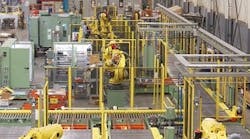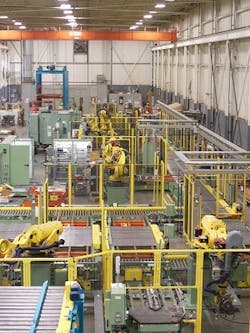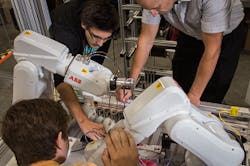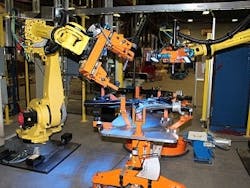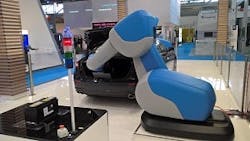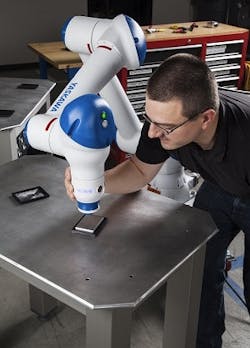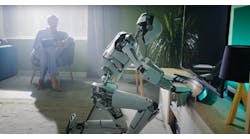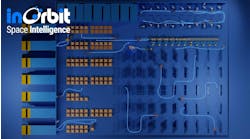A robot's flexibility makes it suitable for use in many applications. Whether you’re starting or expanding the use of robotics, there’s a lot to know when it comes to selection, safety and collaboration.
Start with the unwanted
Robots can help to make the manufacturing process more efficient. If an operator is working on a dirty, difficult, dull or dangerous job, then a robot should be considered (Figure 1). "In order for manufacturing to thrive in the United States, it needs to be competitive in the global marketplace," says Bob Doyle, director of communications at Robotic Industries Assn. (RIA). “The use of robotics and automation helps companies maintain that competitive advantage by producing higher-quality products, makes them more productive and faster, creates a safer workplace and reduces costs all while creating better, higher-paying jobs."
Figure 1: Robots are an excellent choice for dirty, difficult, dull or dangerous jobs.
(Source: Harry Major Machine)
Most customers look at just the technical data sheets when considering robots, notes Chris Blanchette, account manager for assembly robots at Fanuc America. "What is the reach, speed, precision and price?" asks Blanchette. "But probably almost as important as those attributes are the robot OEM’s support infrastructure and product integrated features. Some primary reasons to choose a robot for a manufacturing solution are to add flexibility in the process, improve throughput, reduce ergonomic and safety challenges and improve product quality. A robot OEM who has skilled application engineering resources, product specialists and customer support specialists available, not only in your region but the customer's region, reduces your risk in defining a workable solution and increases the probability that you will understand the robot, the options and how to apply them more effectively in your automated solutions."
The robot reach, speed, precision and price are important, but full utilization of the robot is generally up to the integrator. "A quality simulation can help with this and would be the recommended starting point when beginning a project," says Aaron Brown, senior controls engineer at AeroSpec in Chandler, Arizona. "Keep in mind that a simulation is great for robotic motion analysis and an amazing help with trying to maximize cycle time. However, in order to be truly representative, the simulation needs to be designed around the mechanical design. Most simulations will be directed to cycle time or just a sales tool to give the customer a visual representation of what the cell may look like. It’s difficult to fully understand how the mechanical design, product variations and robot implementation will affect the cell, thus making many simulations inaccurate. Settling times of robot systems and other tool motion delays can add up quickly, and they often take longer than planned."
Undenied flexibility
Watching a robot used in an automotive paint or body-shop welding application dramatically highlights the robot’s flexibility in motion and handling. "Although custom automation will always have its place, there are several reasons why robots are often the preferred solution," says Leon Krzmarzick, controls engineering manager at Delta Technology in Phoenix, Arizona. "Robots provide a degree of versatility that, in some cases, simply is not practical with custom automation." Complex manipulation of parts, for example, often requires an elaborate custom-engineered solution, whereas a robot can be programmed to perform the same part handling with relative ease. If an application changes, the custom solution may require substantial redesign, but a robot may only require programming modifications.
Robots offer greater flexibility in adapting to changes in the product or process over time. "Efforts to modify robot programming and end-of-arm tooling typically provide the benefit of reduced development time, lower cost to implement and shorter ROI realization when compared to custom automation," notes Todd Best, director of business development at Delta Technology. "Also, if the process becomes obsolete or changes considerably, a robot should be considered a redeployable asset that has a high degree of potential reuse elsewhere in a customer’s production process. In contrast, hard-tooled custom automation often is written off when the process becomes obsolete."
Robots provide flexibility to adapt to product changes, both planned and unplanned. "A robot’s application program can quickly be adjusted to correct for product changes,” notes Douglas Tangye, controls engineering supervisor—welding systems at Fori Automation in ShelbyTownship, Michigan. “Dedicated automation may require mechanical design changes, which would require more time, resulting in lost production."
It's the automation that makes the robotic application flexible. "Most industrial robotic applications do indeed require an entire automation system that is engineered and installed by a qualified system integrator," notes RIA’s Doyle. This includes the robot, end effector and surrounding automation—the robot system. The Robotic Industries Assn. offers a Certified Robot Integrator program to help the user to identify qualified integrators to select, design, program and integrate robot systems.
Also read: Applications that will benefit from collaborative robot innovations
Robot selection
There are many things to consider when selecting robots for a new, multi-station assembly application, for example, some of which may include possible human collaboration. "There are a large number of factors to consider when selecting robots for automation," notes Matt Wicks, vice president, product development, manufacturing systems at Intelligrated in Mason, Ohio. "Cost and functionality are at the core of these factors. Collaborative robotics generally have a lower cost point but lack the functionality in terms of reach, payload and speed that more traditional arms provide."
The reach and payloads are capability requirements, notes Frank A. Loria, vice president at Harry Major Machine in Clinton Township, Michigan. Meeting cycle-time requirements and multitasking are important elements for selection of proper robot applications, as well, he says. "The project application type, such as part handling, palletizing, machine tendering or welding, as well as any assembly task—whether it’s totally robot-independent or collaborative with operators—are key takeaway decisions for determining best utilization of robots," says Loria.
When designing a robotic work cell, the machine builder should ask a few key questions. "What is the required cycle time of the machine to get sufficient ROI?" asks Ryan Weaver, automation engineer with Axis New England, a Universal Robots distributor. "Speed and safety can often compete in an application, but it’s important to consider the benefits of removing guarding and allowing for greater operator involvement."
Figure 2: Robot applications vary widely so reach and available area are important decisions.
(Source: House of Design)
As a machine becomes closer to 100% automated, the overall cost tends to rise exponentially, continues Weaver. "Certain tasks can be very challenging to automate, which adds significant cost,” he says. "Those types of tasks include anything subjective, such as bin sorting, or complex inspection tasks. By slowing down the process so that you can consider a collaborative robot, you allow human operators to be involved in the more challenging portions of the task, reducing automation cost."
Overall there are many different items that need to be verified before a robot can be ordered. "As a machine builder you would need to look at many different aspects of the project to select the best robot," notes Shane Dittrich, PE, principal/CEO at House of Design in Nampa, Idaho. "The environment, such as a foundry or clean room, must be considered. Also, the overall area of the application and where the robot needs to reach is a big consideration (Figure 2). The payload of the robot must also be analyzed and verified that it matches the application."
Set the goal
"The machine builder needs to take into account the true end goal of the project and what is needed to best accomplish that goal," says Arnar Thors, president at Fitz-Thors Engineering in Bessemer, Alabama. "Most projects can see a sharp increase of project scope, especially on very tough applications, if the process deliverables are not clearly defined up front. Major items to consider are takt time, part presentation to the cell, part consistency and required fixturing. With this information you can begin to plan and simulate your multi-station layout to verify that the tasks can be accomplished with a 20% robot utilization buffer for future expansion."
When considering the possibility of automating any new manufacturing processes, there are a gamut of robotic or automation choices that boil down to looking closely at each application, says Chris Elston, senior controls engineer, Yamaha Robotics USA. At Yamaha Robotics, engineers become intimate with each project engineer by asking application questions:
- What is your desired cycle time?
- What is the robot work payload?
- How far to do you need to move the object?
- What is the desired repeatability of your process?
"The final parameter to be considered has to do with precision," says Arturo Baroncelli, robotics business unit manager at Comau. "Generally speaking, industrial robots are able to manage elements that need to be processed and located in a definite geometrical position, with adequate and reasonable tolerances. Then the surfaces and reference points need to be sufficiently precise for correct handling, and the functional tolerances of the piece to be processed need to be consistent with the technological operations to be performed. The word 'precision' is key in the approach, but also the word 'adequate.'” It’s unnecessary to require extremely tight tolerances when lesser ones would be sufficient. “Costs of such extreme precision would be become unreasonable," he explains.
Integrator must ensure safety
Figure 3: While the robots are completing auto-torque on the suspension modules, the humans are performing difficult-to-automate work.
(Source: Fori Automation)
A robot is as only as safe as the system design, says Fori’s Tangye. "Robots by themselves are designed with all required safety functionality, but the integrator must take the necessary safety precautions when integrating the robot into any system (Figure 3)."
Krzmarzick from Delta Technology comments that, in collaborative applications, a full-risk assessment is required to determine if the application is suitable for a “cobot.” Payload/end-of-arm-tooling (EOAT) mass, velocity and elevation are some of the factors that may rule out a collaborative robot.
Many of the robots available have extensive safety functions built in, but safety also depends on the application—the robot system. "When designing for safe human-robot collaboration, there are two things to consider: the robot itself and the application," notes Weaver from Axis New England. "Universal Robots offers a collaborative robot that is certified by third parties to meet the current cobot safety standards. The second thing to consider is the application itself and the safety hazards that may present. For example, the robot may be picking up a part with sharp edges and moving it quickly at head-height. In that case, the integrator should consider what is safe if the tool or product were to hit a person."
Figure 4: Not only must the robot successfully perform the work, but it must do it in a manner safe for the personnel and the end products.
(Source: Comau)
It’s a common mistake to consider that the use of a collaborative robot can solve all issues, agrees Comau’s Baroncelli. “In general, one has to focus not only on the robot, but on the whole application,” he says (Figure 4). “A robotic cell is composed, first of all, by the robot itself. There are clear international rules to be fulfilled, which the robot manufacturer is aware of and fully responsible for. But then there is the gripper, which can be awkward and dangerous in terms of its behavior when there is potential contact with a person. Here the responsibility is generally connected with system integrator if the robot manufacturer does not supply the gripper. And then there is the part that, when handled by the robot, becomes part of the extended robot. Last but not least, a robotic cell is also composed of other pieces of equipment such as fixtures, conveyors, presses and furnaces, which are not intrinsically safe. A risk assessment should therefore be done for the whole robotic cell where the necessary safety of the cooperative robot may not be enough to grant a sufficient level of safety to the entire cell. For example, it is one thing to manipulate cookies with soft grippers and another thing to handle red hot iron pieces with hard metal-end effectors. And, once again, the role and responsibility of the system integrator is key in the assessment."
Speed kills
In general, there are applications that have a requirement for operator interaction and others that do not. "Most of the very high-speed assembly applications are best built with physical safety guarding," says Rick Brookshire, senior manager—product development and marketing, Epson Robots. "This is the most safe solution and will protect from the unexpected."
Most of Epson Robots' customers continue to prefer safeguarding even though discussions of collaborative robots are certainly a hot topic in the industry, says Brookshire. "Usually, the problem with true collaborative robots is that they need to run slowly and then can’t meet throughput requirements for high-speed, high-throughput applications," he says. "However, a compromise solution is to use zone safety devices such as laser area scanner sensors to map an area around a robot to detect the presence of humans or objects moving into the robot space and adjacent space. These devices allow high-speed operation when operators are not near the robots and then detect approaching operators and slow down or stop when operators get close and their safety is in question."
Robot standards
With regard to robot safety standards, OSHA compliance is a legal requirement in the United States and should be the first stop for an integrator, says Bill Edwards, manager, Technology Advancement Team, at Yaskawa America's Motoman Robotics division. "From there, they should move on to the voluntary consensus standards, first and foremost being the ANSI/RIA 15.06 2012,” he explains. “This specification is essentially identical to ISO 10218, parts 1 and 2, and takes a global approach to robotic safety standards with manufacturer requirements found in Part 1 and the system integrator’s/end user’s requirements found in Part 2. A good working knowledge of ISO 13849, Safety of machinery—Safety related parts of a control system, and ISO 12100, Safety of machinery—General principles for design—Risk assessment and risk reduction, is also very helpful. Additionally, there were three technical reports created by the RIA to help to fill the gaps in information no longer addressed in the revised 15.06. These are TR R15.306, Task-based risk assessment methodology, which relies heavily on ANSI B11.0, TR R15.406, Safeguarding, and TR R15.506, Applicability of ANSI/RIA R15.06-2012 for existing industrial robot applications. If the system design calls for a collaborative solution, then ISO/TS 15066:2016, Robots and robotic devices—Collaborative robots, would also be useful."
When implementing a robot system, collaborative or otherwise, the integrator and end users must take safety into consideration. "Just because the arm is collaborative does not give the integrator/end user a free pass; the system must still be assessed for safety," says Intelligrated’s Wicks. "Is a knife-wielding collaborative robot safe? No, of course not, so steps must be taken to protect individuals in this environment. ANSI/RIA R15.06-2012 and ISO/TS15066 are industry standards that should be understood when considering any robotic deployment. Some popular uses of collaborative robotics have been in machine tending, worker assistive functions and light manufacturing or packing."
Collaborative apps
Collaborative robots actually refer to a robot system, rather than a particular type of robot, says RIA’s Doyle. "With a collaborative robot application, humans and robots can occupy the same workspace at the same time while the system is in automatic mode," he says. "There are still safeguards and a risk assessment required, in accordance with the robot system safety standard ISO 10218-1 and -2:2011. For now, the collaborative workspace will most likely be a small defined space with familiar fencing or other safeguards surrounding the rest of the robot."
Figure 5: Hand guiding is just one of four collaborative modes discussed in the RIA robot safety standards.
(Source: Yaskawa)
The RIA updated robot safety standards and defined some conceptual applications of collaborative robots including:
- hand-over window
- interface window
- collaborative workspace
- inspection
- hand-guided robot.
"Each of these applications offers its own specifications of safeguards that must be met, which are now categorized into four collaborative modes of operation," says Yamaha Robotics’ Elston. Those modes are:
- Safety-rated monitored stop: Operator may interact with robot when it is stopped. Automatic operation resumes when the human leaves the collaborative workspace.
- Hand guiding: Operator is in direct contact with the robot, using hand controls.
- Speed and separation monitoring: Robot/hazard speed is reduced the closer an operator is to the hazard area. Protective stop is issued when operator is in potential contact.
- Power and force limiting: Incidental contact between robot and person will not result in harm to person.
"Typically, robots are guarded with machine guarding and controlled via a safety supervisory system or hardwired safety contacts," says Elston. "From a safety standpoint, seeing a robot behind a fence or a guard just puts most people at ease. It’s easier to understand that the robot is over there and I am protected over here in a safe environment, divided by a safety barrier."
To be clear, integrators must perform a risk assessment and consider the robot system as a whole. "What dictates whether or not a particular collaborative mode can be used depends on a comprehensive risk assessment and applicable safety specifications,” says Yaskawa’s Edwards. "The risk assessment should take into account the entire system including the robot, part, end effector and adjacent machinery."
While the technology has been available for some time to perform all of these tasks, the specifications previously did not allow for its use or provide adequate guidance on how it could be used safely, explains Edwards (Figure 5). With knowledge of the relevant standards, a comprehensive risk assessment and use of current robotic technology, it is no longer a foregone conclusion that robots and humans can’t work together safely on the manufacturing floor.
